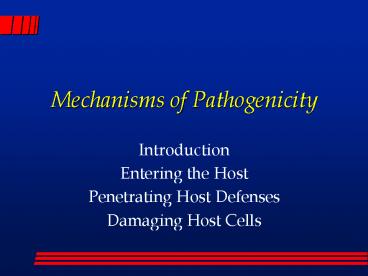Mechanisms of Pathogenicity - PowerPoint PPT Presentation
Title: Mechanisms of Pathogenicity
1
Mechanisms of Pathogenicity
- Introduction
- Entering the Host
- Penetrating Host Defenses
- Damaging Host Cells
2
Pathogenicity - Introduction
- Pathogenicity is the ability of a pathogen to
produce disease by overcoming host defenses - Virulence is the degree of pathogenicity
- Expressed as LD50 (lethal dose necessary to kill
50 of the inoculated hosts) - ID50 is also used (dose necessary to infect 50
of the inoculated hosts)
3
Pathogenicity Entering Host
- Route of entry is called Portal of Entry
- Usual portals include mucous membranes
- Conjunctiva (eyes)
- Respiratory tract
- Gastrointestinal tract
- Genitourinary tract
4
Pathogenicity Entering Host
- Respiratory most common
- Microorganisms are inhaled on moisture droplets
or dust particles - Genitourinary through mucous membranes and direct
contact - Gastrointestinal through food, water and
contaminated fingers
5
Pathogenicity Entering Host
- Most microorganisms cannot penetrate skin but can
gain access through hair follicles and sweat
ducts - Can gain entry through inoculation also called
parenteral - insect bites
- injections
- wounds
6
Penetrating Host Defenses
- Bacterial Elements that Overcome Host Defenses
- Capsules
- Cell Wall Components
- Enzymes
- Cytoskeletal Components
7
Penetrating Host Defenses
- Capsules
- Prevent or reduce phagocytosis
- Usually polysaccharide
- Examples
- Dextran (S. mutans)
- Polyglutamic acid (B. anthracsis)
8
Penetrating Host Defenses
- Cell Wall Components
- Adhesins (adhere to complementary receptors on
host cells - Fimbriae interact with membrane glycoproteins
especially mannose - Some microbes reproduce only in host cells
9
Penetrating Host Defenses
- Enzymes
- Leukocidins destroy white blood cells
- Hemolysins destroy red blood cells
- Kinases digest blood clots
- Hyaluronidase digests mucopolysccharides
- Collogenase destroy collogen of connective
tissue
10
Penetrating Host Defenses
- Via Cell Cytoskeleton
- Invasins
- Cause actin of microfilaments to form basket to
carry bacteria into cell - Found in Salmonella
11
Damaging Host Cells
- Damage by metabolizing and reproducing in hosts
- Damage by the production of toxins
- Two major types of toxins
- Endotoxins
- Exotoxins
12
Damaging Host Cells
- Exotoxins
- Usually from Gram positive bacteria
- Usually a secreted protein product
- Heat Labile (60 to 80 deg C)
- Very toxic low LD50
- Usually specific for cell type or cell function
- Can be neutralized by antibodies
- Symptoms usually appear sooner
13
Damaging Host Cells
- Exotoxins Examples
- Diptheria toxin stops protein sysnthesis
damages heart and other organs - Cholera toxin affects intestinal cells disrups
cAMP a cell secondary messenger - Tetnus toxin affects nerve transmission
- Toxic shock affects T-cells macrophages
- Listeriolysin pore forming cytotoxin allows
cell to escape phagocytic vesicle
14
Damaging Host Cells
- Endotoxins
- Almost exclusively Gram negative
- Present in LPS and released with destruction of
cell - Heat stable often can withstand autoclave
- Not easily neutralized by antibodies
- Produces general effects fever, aches, shock
- Much larger LD50 than exotoxins
15
Damaging Host Cells
- Endotoxins Examples
- Salmonella typhi and typhoic fever-incubation
period 1 week symptoms due to LPS induced
release of cytokines enter blood and multiply in
spleen and liver - S. enteriditis S. typhimurium food borne
gastroenterits symptoms usually appear within
24 to 48 hours takes longer than with S. aureus
exotoxin































